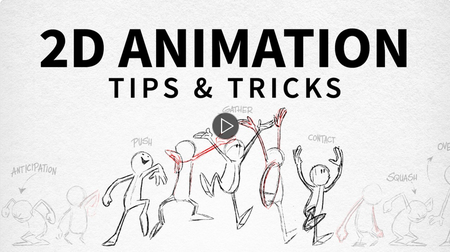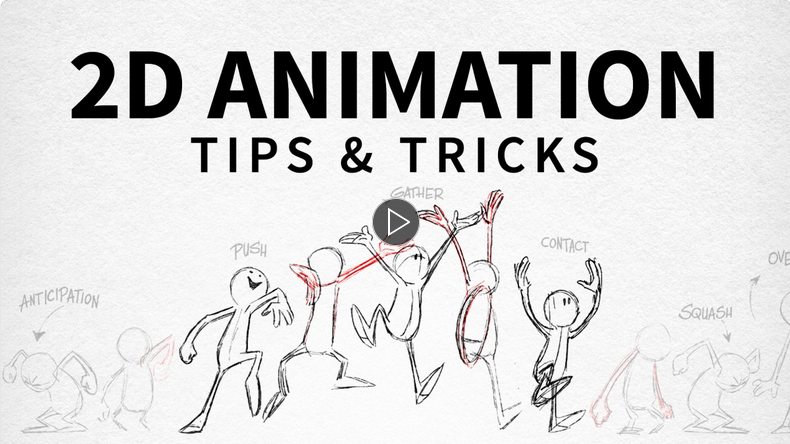2D Animation: Tips and Tricks (Updated 02/09/2021)
Linked Learning | Duration : 17:36:00 | Size: 2.9GB
Linked Learning | Duration : 17:36:00 | Size: 2.9GB
Bluth-style design
“
- [Instructor] When you look at, say, "Jungle Book", "101 Dalmatians", or "The Secret of NIMH", and you compare it to "Sleeping Beauty' or many of the movies that came before, there's a much bolder use of straights versus curves. And I don't know exactly why it became more pronounced in this period, but it certainly did. I wonder if it just comes down to people getting better and better, and they're just drawing faster. I find when I draw faster, that style begins to just come out as a function of speed sometimes. And I think they were genuinely just, at that point, on top of their craft. Also, it's definitely harder to work with straights. One reason why the stuff from the 1930s was rounder was it was more forgiving. So it could be also a fact that people are just really confident, and they weren't afraid of angles. So on the left side, you have curves, like something you'd see in the 1930s, maybe early '40s. The middle one is all straight. So I just did that as an extreme example, but it's like something you'd see from, I guess, a Warsaw Pact country in the 1980s. And on the right, something that's slightly in the middle of the two, like a hybrid. And that's sort of where they went. They went much stronger with that kind of thing. And you see that tendency of, the struggle between curves versus straights. And I think, at some point in the mid to late '60s, the straights were getting stronger. And I think that's one reason why those cartoons are just so much better looking as well. So again, that's the difference. And the other thing, too, they were just solid draftsman. I mean, you could take any given drawing, and there's construction beneath it. And that was always there. So this is just something that they had from day one on "Snow White". But I think, by the end, people are just getting better and better and more confident with these characters from all kinds of bizarre angles. And the other thing, too, that you notice as well, is more complexity, especially with the later Bluth work, like "The Secret of NIMH". Extreme complexity on things like eyebrows, bushy eyebrows, hair, clothing, with chunks out of it, and things that might've been avoided earlier, because maybe the burden on the inkers would have been too great to get away with this kind of thing. One of my least favorite things to work on when I worked for Bluth was braided hair. It really summed up the obsession with dimension and getting the form right. But I think this is a good example. And this is from my drawing course about drawing cartoon characters in animation. And so what I've done throughout this movie is I've pulled out the drawings from that course that I think come closest to capturing that aesthetic, that style. This is a good one, because it shows the principle of straights and curves. And part of the craft of doing this properly is knowing which part of the body should be straight and which should be curved, getting braver with that and bolder with that. So if you are feeling less confident, maybe you put more curves in. But the more confident the draftsman, or draftsperson, is, then the bolder those straights get. And I think that's what you see happening. And I think it reaches the apex in "Dragon's Lair" and "Space Ace" where the forms are really strong. Straights against curves are great too, because they create really strong contrast. The negative shapes or the positive shapes are much better as a result of this. And if you look at the bottom arm there, the red is closer to the bone, so hence, straighter. The muscle and fat is above that, so that's where the curves are going to be. So this is the dynamic, the graphical struggle, between straight against curve, and where do you put ONE, vis-a-vis the other, and how do they relate to one another? And again, another good example with the face. The red corresponding, roughly, with bone, or hard cartilage, and the blue with things that are soft. Another thing that kind of stands out from this period too is bigger feet and really strong foot shapes. And I love drawing feet too. I think they're great fun. And they are these tricky little combinations of pyramids. But once you become comfortable with the family of foot shapes, as well, it really makes life a lot easier. And dimension, as well, is a constant. I mean, look at the necklace. I mean, we would never be allowed just to draw one half of it. You'd always have to imagine the necklace wrapping around the neck. Where is it on the other side? We're not dealing with flat forms here. They constantly told you you're not drawing lines, you're drawing volumes. And another kind of tell-tale feature from the Bluth studio was the use of warts and freckles. A nightmare then to animate, because then you have to plot them. If you look at the guy in the bottom left with the little red dots, you'll see, you have to find the ingenious ways to plot these things on the face. So as the character talks, they're not floating around and sliding around the anatomy. Another subtlety is doing a break on a curve. In other words, don't just have a curved line, put a very slight indent or a break on it. Again, where appropriate, not just willy-nilly. And I found that as the studio went on, unfortunately, the character designs got rounder and rounder, and the straights became weaker and weaker. And I've always felt sad about that. I wasn't the only one. I love drawing straight lines. And I find when I get tired, my drawings get rounder and rounder. And then, I look at them after a couple of hours and go, "We need to put some straight lines back in." But these are two examples of round character designs. And you can work with them, but it's so much nicer if you can… Like the big (indistinct) guy on the right, He will be much stronger if I went in with a red line and put in some actual straights in there, instead of just all these curves. Another hallmark of this period is really strong mouth shapes, really strong teeth as well. And note, as well, the kind of irregular spacing of the gaps between the teeth, little holes here, and the classic Don Bluth tongue would be the one in the middle. One of my former directors used to joke that it was like a potato chip. And as opposed to the 1930s style, or this more naturalistic one here. And this will be another very common trick that was used as well. So it helps to misalign the teeth in a very unnatural way, and that's another kind of useful trick that was used a lot. It creates this really nice triangular shape here, which is a much stronger, negative shape. And all those principles are applied, then, in this kind of canine mouth as well, the potato chip tooth, irregular teeth spacing, the upper and lower jaws slightly misaligned. And this is one of the birds I did for my drawing course. And a little bit inspired, I think, by Jeremy from "The Secret of NIMH". And a magpie on the left. And then I colored him as a crow or a raven and the other two using an incline effect here, or instead of… This looks better actually, just painting the wing tips a slightly different color so that the negative shape works. So that's just a quick overview of some, some, not all, of the design processes. And again, look at the level of detail with these different feathers. It was just an increase of confidence that we could handle these complex shapes. We can move them around, that they won't wiggle and dance. Sometimes, they did though. If you look critically at a lot of these movies, even the best of them, there's always those scenes where the hair does things that are strange, or feathers do things that are, like the little things they shouldn't perhaps. But essentially, that's the gist of it. Don't be afraid of straight lines. Increasingly, try to put them where they should go and not just because. And I've seen this done. People imitating that aesthetic and putting down straights against curves a little willy-nilly. They go where they go for a reason. It's not arbitrary. And then, the difficulty that you will face is animating these very strong shapes, Because they are harder to move around.



